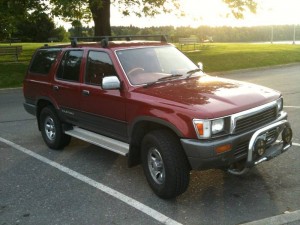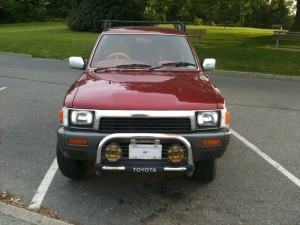PEI – Reading the News Brief
I've been re-reading the News Brief and it seems that RHDs are not outright banned.
Once legislation is passed, right-hand-drive vehicles will have to meet Canadian Motor Vehicles Safety Standards in order to be registered. Vehicles that have already been registered in the province can continue to be used.
By the sounds of this, the legislation has not passed (but likely will) and existing RHDs are ok. By the sounds if it there will not be an all-out ban.
I know that my 1990 Daihatsu Hijet does not have a catalytic converter, so might not pass emissions test. My friend's 92 Hijet does, and likely would pass.
I don't know how private insurance works, since I live in a province with public insurance. I'll keep doing some research to find out more about the proposed legislation.
rob
Right hand drives banned from PEI
Another province has fallen. PEI has banned right hand drive vehicles.
All 30 of them in the province. Here is the release from the Government of PEI.
No word what will happen with the RHDs that have been banned. Quebec allowed the RHDs that were on the road to stay on the road... I don't know if PEI will follow suit. I'll try to find out.
rob
UPDATE: check out the newer post.
The orgins of right-hand drive/left-hand drive
Once again, the cruising of the internet has made an interesting article crop up.
Check it out if you're interested in the origins of right and left hand drive traffic.
http://www.feras.co.uk/when-did-european-cars-change-to-left-hand-drive/
rob
Thoughts about the Toyota Hilux Surf
In my cruising of the internet, I stumbled upon a Kijiji ad that was surprisingly informative about Hilux Surf detailing what kinds of gotchas they have. After reading it I immediately requested permission to post it here.
Some details about the Hilux Surf. The Hilux Surf is the RHD equivalent of the Toyota 4Runner. The Hilux Surf was offered in a Turbo Diesel 4 Cylinder model. This model has become very popular as a grey market import due to it's ruggedness, 4 wheel drive and very respectable fuel efficiency.
With no further adieu, here are Toby's very balanced thoughts about the Toyota Hilux Surf.
So what about these vehicles? here's the deal (read: my opinion)
They're absolutely fantastic, I've only ever taken it off road a few times down old logging roads but this truck is part billy goat I'm sure. They are dependable and rugged (not quick though) and will go forever. that being said there are things to watch out for in buying mine of any body else's.
And they are:
Make sure the Head has been done!!! The factory heads have a few issues one being the alloy content and two being the cooling veins are too close to the cylinder heads. It is not a matter of will the head crack but when. The BEST remedy for this is an OEM replacement, there are 3 litre fixes and others but the best best is going with the Toyota replacement hands down. Once the head has been fixed Properly these trucks will last forever!
If it doesn't have an EGT gauge or the equivalent runnnnn!!! This is one of the best ways to monitor engine temp and care for the vehicle while driving. It stands for Exhaust Gauge Temperature and displays the temperature of the exhaust coming form the engine itself. Although the temperatures are bound to be different this is the best indicator that you can keep the hammer down or should gear down and back off a little.
Make sure to have a place to service them!!! I would recommend ATEB (http://www.ateb.ca/index.php) for all RHD diesel needs. They are some of the best mechanics around and have all the parts you need. When it came time to do my head they had one in stock!!! Oil Filter? Yep! There are other shops as well that I hear are great, but this is the only one I have used.
If you're buying a 1989 through 1993 2.4L Hilux make sure it's the 2LT as opposed to the 2LTE the difference is the electronic injection. Although it is not a faulty system by nature it can cost a small fortune to have replaced!! From my knowledge the 1KZ engine found in these trucks from '93 or '94 onward are bullet proof out of the factory but are certainly a little more money.
One last thing, I will never get the money I have put into this truck back in the sale of it. Nor will anyone. If you see some one selling a 2.4L Hilux for more then 10 or 11K they better have lifted it to the moon or have a secret Engine elf inside that makes the exhaust turn into cookies. They simply aren't worth that much as they are. Anywhere up to $9,000 though for a good truck is worth while. I have priced mine where it's at to hopefully encourage a quicker sale (really don't want to insure 2 vehicles longer then I have to) and to reflect the dents on the back and front left side. To fix the damage is about $1000 and then the truck would be just this side of mint...ish.
And finally be aware of any aftermarket change people have made such as lifting the truck (to ride higher) or engine mods (put a larger turbo on) these if not doen properly can cause you much pain in the future and even if done properly MAY raise your insurance a surprising amount.
The Hilux's have the surprising advantage of being identical to the Toyota 4runner that was sold here in Canada. Although the engine and some steering parts are different you can go to an auto wrecker and get an ashtray anytime.
Thanks for reading and good hunting, feel free to call or email and I hope to hear from ya soon!
Toby
ps from Rob. If the truck is still available, it's available here.
What’s it like driving a right hand drive?
This is a common question. Usually followed up by, "Is it safe to drive a right hand drive?"
Clearly these questions can be translated to, "Is is safe to drive a right hand drive in a left hand drive country?"
The answer really lies with the person behind the wheel. That being said, driving an RHD in a LHD country does have it's gotchas, but they're not as bad as you might expect.
In a straight line, it's the same. It feels strangely not unusual to be 'driving from the passenger seat'. If you think about it, you've sat in the passenger seat of a car quite a few times in your life... now there just happens to be a steering wheel there. But, you know where the car should be sitting on the road and it doesn't feel awkward. Shifting with the left hand (given you have a manual transmission) is also surprisingly natural. And, consider this. The majority of the population is right-handed. Should your dominant hand be doing what's keeping your alive (steering) or not (shifting). So, it actually makes some sense!
In a straight line, it's the exact same dangerousness (let's make up some words!) as driving in the far left lane in a multi-lane one-way. Really, not that hard.
Where you will get a little hung up is turning. Left turns across large intersections can be a little tricky. Usually, in a LHD, you can nose in and try to look past the vehicle across the intersection that's also trying to make a left turn.... even this is often hard in a LHD. In a RHD you're further right in the car and have to nose even further in to see past obstructions. It's not often that it's an issue, but it can be.
The blind spots in RHD are similar to LHDs, but the mirror image. One thing that keeps catching me is this: when doing a right-on-red I nose into the intersection and turn a little to the right. This shifts my passenger up a bit and no they're in my line of sight. Easy to fix. Either lean forward, ask them if there is traffic, or don't have a passenger. After a bit you don't do that any more. There are the same problems when you're driving a LHD, but you don't think about them anymore. The same thing happens in an RHD. You just adjust and forget about it.
There are some publications saying how dangerous RHDs are in LHD traffic. SAAQ (Quebec's public insurance) has published a document detailing their statistics in attempts to show that RHDs are a menace on the roads. I feel that this document is flawed, but won't get into that right now. They make some good point, and is overall a good read. I don't think that it's sufficient evidence to stop insuring RHDs.
ICBC (BC's public insurance) has published a document in the same vein as SAAQ. ICBC has acknowledged that the findings are difficult to interpret since there are no sure-shot ways of discovering whether or not a car that is insured is right hand drive or not.
Both of these documents have their valid points. There is major points for skew though. They, again, are worth the read.
Overall, it's the same, just different. It's no more dangerous than any other vehicle if you're paying attention and not driving like a moron. Some (maybe even most) of these cars that are brought in are high power cars that are difficult to not drive like a moron. This might be the problem, but it's a problem with the drivers, not the cars.
rob

